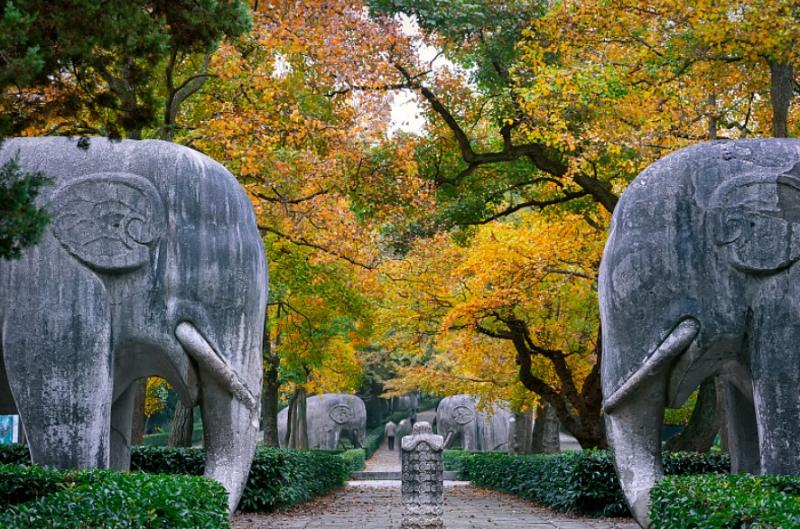Ming Xiaoling Mausoleum

Nanjing: The Ming Xiaoling Mausoleum
Ming Xiaoling Mausoleum, located at the southern foot of Zijin Mountain in Nanjing, is the tomb of Emperor Zhu Yuanzhang, the founding emperor of the Ming Dynasty, and his empress. It is one of the most magnificent and imposing imperial mausoleums in ancient China and was listed as a World Heritage Site in 1987.
I. Historical Origins
- Early Ming Dynasty: After establishing the Ming Dynasty in 1368, Zhu Yuanzhang began planning his mausoleum and officially commenced its construction in 1378.
- Site Selection: The selection of the burial site involved numerous inspections and evaluations. Ultimately, the southern foot of Zijin Mountain was chosen, not only because of its majestic terrain and auspicious feng shui but also because of Zhu Yuanzhang's personal love for landscapes.
- Construction Period: The construction of Ming Xiaoling Mausoleum spanned over 20 years, involving a massive amount of manpower and resources. It finally culminated in this grand and magnificent tomb.
II. Mausoleum Structure
- Spirit Way: Serving as the entrance to the mausoleum, the Spirit Way stretches for approximately 2.7 kilometers. Stone lions, elephants, and tigers line both sides, creating an imposing and majestic atmosphere, signifying the imperial grandeur.
- Stele Forest: The Stele Forest, located on both sides of the Spirit Way, records the construction process, important figures, and achievements of Ming Xiaoling Mausoleum. It serves as valuable historical data for studying the Ming Dynasty.
- Imperial River: The Imperial River, winding its way alongside the Spirit Way, creates a solemn and dignified atmosphere in harmony with the Spirit Way.
- Civil and Military Gate: The Civil and Military Gate stands at the end of the Spirit Way, marking the entrance to the core area of the mausoleum and is one of the iconic structures of the entire complex.
- Longen Hall: Inside the Civil and Military Gate lies Longen Hall, dedicated to commemorating Zhu Yuanzhang and Empress Ma. The hall houses stone statues of Zhu Yuanzhang and Empress Ma.
- Treasure Peak: At the heart of the mausoleum, the Treasure Peak is a towering stone monument marking the joint tomb of Zhu Yuanzhang and Empress Ma. It is also the highest point of the entire Ming Xiaoling Mausoleum.
III. Architectural Features
- Grand Scale: Spanning approximately 170 hectares, Ming Xiaoling Mausoleum is the largest of all imperial mausoleums from the Ming and Qing dynasties, reflecting Zhu Yuanzhang's imperial spirit and the supreme authority of the imperial power.
- Strict Layout: The overall layout of Ming Xiaoling Mausoleum adheres to the traditional principles of ancient Chinese architecture, prioritizing "dragon and tiger" symbolism and "yin and yang" order, reflecting the ancient reverence for heaven and earth and the pursuit of order.
- Exquisite Stone Carvings: The stone carvings in Ming Xiaoling Mausoleum are exquisitely crafted, with vivid and lifelike forms, representing the highest level of ancient Chinese stone carving art.
- Architectural Style: The architectural style of Ming Xiaoling Mausoleum is solemn and majestic, reflecting the grand scale and simple yet elegant features of Ming Dynasty architecture.
IV. Historical and Cultural Value
- Historical Relics: Ming Xiaoling Mausoleum stands as a significant historical testament to the Ming Dynasty. It houses numerous relics, including stone carvings, inscriptions, and architectural structures, providing invaluable data for researching the history of the Ming Dynasty.
- Cultural Heritage: Ming Xiaoling Mausoleum is an outstanding cultural heritage of the Chinese nation, representing the highest level of ancient Chinese architectural and sculptural art. It holds significant importance for studying ancient Chinese culture.
- Tourist Attraction: Ming Xiaoling Mausoleum is also a renowned tourist destination, attracting visitors from around the world each year. It has made significant contributions to the development of Nanjing's cultural tourism industry.
V. Current Situation and Protection
- Present Situation: Today, Ming Xiaoling Mausoleum is well-preserved and has become an important cultural tourism resource in Nanjing, attracting numerous visitors.
- Protection: As a World Heritage Site, Ming Xiaoling Mausoleum receives high regard from the national and local governments. Active protection and restoration efforts are underway to ensure the transmission of this invaluable historical and cultural heritage for generations to come.
Ming Xiaoling Mausoleum, as a masterpiece of ancient Chinese imperial mausoleums, reflects both the supreme authority of the Ming Dynasty and the cultural charm of the Chinese nation. This magnificent mausoleum will forever stand on Zijin Mountain in Nanjing, serving as a historical witness and a symbol of Chinese culture.